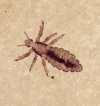Safety, Efficacy, and Physicochemical Characterization of Tinospora crispa Ointment: A Community-Based Formulation against Pediculus humanus capitis
- PMID: 28877572
- PMCID: PMC5594725
- DOI: 10.3347/kjp.2017.55.4.409
Safety, Efficacy, and Physicochemical Characterization of Tinospora crispa Ointment: A Community-Based Formulation against Pediculus humanus capitis
Abstract
The high prevalence of pediculosis capitis, commonly known as head lice (Pediculus humanus capitis) infestation, has led to the preparation of a community-based pediculicidal ointment, which is made of common household items and the extract of Tinospora crispa stem. The present study aimed to evaluate the safety, efficacy, and physicochemical characteristics of the T. crispa pediculicidal ointment. The physicochemical properties of the ointment were characterized, and safety was determined using acute dermal irritation test (OECD 404), while the efficacy was assessed using an in vitro pediculicidal assay. Furthermore, the chemical compounds present in T. crispa were identified using liquid-liquid extraction followed by ultra-performance liquid chromatography quadruple time-of-flight mass spectrometric (UPLC-qTOF/MS) analysis. The community-based ointment formulation was light yellow in color, homogeneous, smooth, with distinct aromatic odor and pH of 6.92±0.09. It has spreadability value of 15.04±0.98 g·cm/sec and has thixotropic behavior. It was also found to be non-irritant, with a primary irritation index value of 0.15. Moreover, it was comparable to the pediculicidal activity of the positive control Kwell®, a commercially available 1% permethrin shampoo (P>0.05), and was significantly different to the activity of the negative control ointment, a mixture of palm oil and candle wax (P<0.05). These findings suggested that the community-based T. crispa pediculicidal ointment is safe and effective, having acceptable physicochemical characteristics. Its activity can be attributed to the presence of compounds moupinamide and physalin I.
Keywords: Pediculus humanus capitis; Tinospora crispa; dermal irritation; ointment; pediculicidal assay.
Conflict of interest statement
The authors of this article have no issues that might lead to a conflict of interest.
Figures




Similar articles
-
Prevalence and treatment of Pediculus humanus capitis with 1% permethrin and 0.4% d-phenothrin in Turkey.Acta Medica (Hradec Kralove). 2003;46(2):73-5. Acta Medica (Hradec Kralove). 2003. PMID: 12926604 Clinical Trial.
-
Pediculicidal treatment using ethanol and Melia azedarach L.Parasitol Res. 2015 Jun;114(6):2085-91. doi: 10.1007/s00436-015-4394-2. Epub 2015 Mar 12. Parasitol Res. 2015. PMID: 25758585
-
Contact and fumigant toxicity of hexane flower bud extract of Syzygium aromaticum and its compounds against Pediculus humanus capitis (Phthiraptera: Pediculidae).Parasitol Res. 2011 Nov;109(5):1329-40. doi: 10.1007/s00436-011-2425-1. Epub 2011 May 4. Parasitol Res. 2011. PMID: 21541752
-
Pediculus humanus capitis: an update.Acta Dermatovenerol Alp Pannonica Adriat. 2008 Dec;17(4):147-54, 156-7, 159. Acta Dermatovenerol Alp Pannonica Adriat. 2008. PMID: 19104739 Review.
-
Spinosad: in pediculosis capitis.Am J Clin Dermatol. 2011 Oct 1;12(5):349-53. doi: 10.2165/11208070-000000000-00000. Am J Clin Dermatol. 2011. PMID: 21834600 Review.
Cited by
-
An updated and comprehensive review on the ethnomedicinal uses, phytochemistry, pharmacological activity and toxicological profile of Tinospora crispa (L.) Hook. f. & Thomson.Phytochem Rev. 2023;22(1):211-273. doi: 10.1007/s11101-022-09843-y. Epub 2022 Nov 3. Phytochem Rev. 2023. PMID: 36345416 Free PMC article. Review.
References
-
- Diaz JH. The epidemiology, diagnosis, management, and prevention of ectoparasitic diseases in travelers. J Travel Med. 2006;13:100–111. - PubMed
-
- McNair CM. Ectoparasites of medical and veterinary importance: drug resistance and the need for alternative control methods. J Pharm Pharmacol. 2015;67:351–363. - PubMed
-
- Austin NI. Pediculosis among school children, in Owerri north local government area of Imo State, South Eastern Nigeria. Int J Infect Dis. 2016;45:352–353.
-
- Roberts RJ. Clinical practice. Head lice. N Engl J Med. 2002;346:1645–1650. - PubMed
MeSH terms
Substances
LinkOut - more resources
Full Text Sources
Other Literature Sources
Medical

